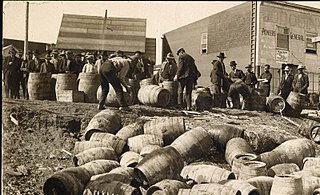 W
WProhibition in Canada was a ban on alcoholic beverages that arose in various stages, from local municipal bans in the late 19th century, to provincial bans in the early 20th century, and national prohibition from 1918 to 1920. The relatively large and powerful beer and alcohol manufacturing sector, and the huge working class that purchased their products, failed to convince any of the governments to reverse their stance on prohibition. Most provinces repealed their bans in the 1920s, though alcohol was illegal in Prince Edward Island from 1901 to 1948. By comparison, Ontario's temperance act was in effect from 1916 to 1927.
 W
WThe Canada Temperance Act, also known as the Scott Act, was an Act of the Parliament of Canada passed in 1878, which provided for a national framework for municipalities to opt in by plebiscite to a scheme of prohibition. It was repealed in 1984.
 W
WFort Whoop-Up was the nickname given to a whisky trading post, originally Fort Hamilton, near what is now Lethbridge, Alberta. During the late 19th century, the post served as a centre for trading activities, including the illegal whisky trade. The sale of whisky was outlawed but, due to the lack of law enforcement in the region prior to 1874, many whisky traders had settled in the area and taken to charging unusually high prices for their goods.
 W
WGovenlock is an unincorporated community within Rural Municipality of Reno No. 51, Saskatchewan, Canada. Previously held the status of a village with a peak population of 151 residents, until its village status was dissolved on January 1, 1976. The former townsite of Govenlock is located on Highway 21 & Highway 13 also known as the historic Red Coat Trail, about 15 km east of the Alberta-Saskatchewan border. Very little remains of the former village of Govenlock, many cement foundations and wooden sidewalks can still be found scattered around the town site, the only building that still stands as of 2010 is the old community hall and a commemorative plaque in remembrance of Govenlock's rich history.
 W
WMalahat, a large 5-masted lumber schooner from Vancouver, BC, was known as "the Queen of Rum Row" in her day. She became famous for rum-running on the US Pacific Coast between 1920 and 1933. The Vancouver Maritime Museum says that Malahat delivered "more contraband liquor than any other ship."
 W
WRum-running or bootlegging is the illegal business of transporting (smuggling) alcoholic beverages where such transportation is forbidden by law. Smuggling usually takes place to circumvent taxation or prohibition laws within a particular jurisdiction. The term rum-running is more commonly applied to smuggling over water; bootlegging is applied to smuggling over land.
 W
WRum-running in Windsor, Ontario, Canada, was a major activity in the early part of the 20th century. In 1916, the State of Michigan, in the United States, banned the sale of alcohol, three years before prohibition became the national law in 1919. From that point forward, the City of Windsor, Ontario was a major site for alcohol smuggling and gang activity.